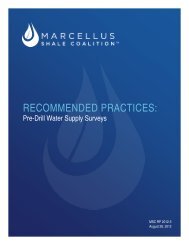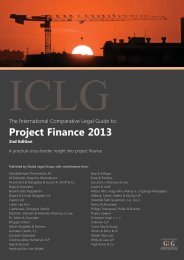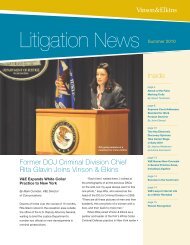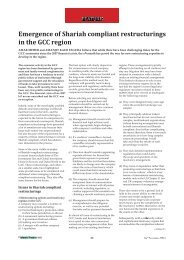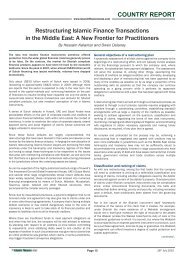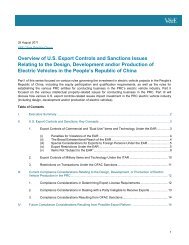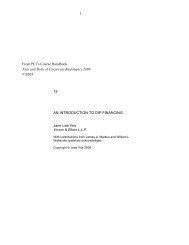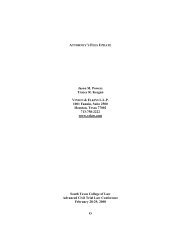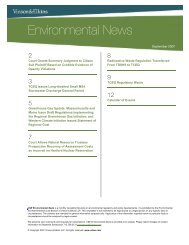TEXAS TRANSNATIONAL LAW QUARTERLY - Vinson & Elkins LLP
TEXAS TRANSNATIONAL LAW QUARTERLY - Vinson & Elkins LLP
TEXAS TRANSNATIONAL LAW QUARTERLY - Vinson & Elkins LLP
Create successful ePaper yourself
Turn your PDF publications into a flip-book with our unique Google optimized e-Paper software.
<strong>TEXAS</strong> <strong>TRANSNATIONAL</strong> <strong>LAW</strong> <strong>QUARTERLY</strong> – June 2009standards), then the current GHG registry rulesmay remain.State Pre-emptionThe new cap-and-trade program mandated byACESA would not completely pre-empt stateGHG regulations. Instead, new Title VIII, Part Fto the CAA would place a six-year moratorium(2012-2017) on the implementation orenforcement of analogous GHG emission caps.The moratorium only applies to state GHGcontrols that are based on an absolute tonnagelimit and preserves the right of the states tomaintain alternative GHG control measures(e.g., emission performance standards) or toadopt programs addressing entities that are notcapped at the federal level. There is also noattempt to pre-empt state GHG reporting rules.To assist entities facing significant compliancecosts under three existing state GHG caps —the Regional Greenhouse Gas Initiative (RGGI),the Western Climate Initiative, andCalifornia Assembly Bill 32 — Part H of Title III(at Section 790) directs the EPA to adoptallowance exchange rules. Under the rules,state GHG allowances issued prior to January 1,2012, when the federal program generallybecomes effective, can be exchanged for federalemissions allowances in an amount sufficient tocompensate a party for the cost of obtaining andholding the state allowances. Federalallowances so exchanged are to be subtractedfrom the allowance pool that would otherwise beauctioned.Oversight of Carbon MarketsThe cap-and-trade scheme established byACESA would be likely to create a market forU.S. emissions allowances and offset creditstotaling over $50 billion a year in 2012.Accordingly, ACESA provides for oversight ofthe market for carbon rights and derivativeinstruments by the FERC and the CommoditiesFuture Exchange Commission (CFTC). TheFERC is given jurisdiction over trading ingovernment-issued allowances and offsets. 5The CFTC would regulate derivatives, (futurescontracts, swaps) unless an interagency workinggroup to be convened by the Presidentrecommends otherwise; in that event additionallegislation might be required.Regulators must adopt strict measures toprohibit fraud, market manipulation, and excessspeculation. Rules to foster market transparencyand to limit or eliminate counterpartyrisk, market power concentration risks, and otherrisks associated with over-the-counter tradingare also mandated.The FERC and any other federal agency withjurisdiction over the trading of any regulatedemissions right or contract is granted the sameenforcement powers as the CFTC. Marketmanipulation, fraud, and false or misleadingstatements regarding a regulated instrument is afelony punishable by up to 20 years in prisonand a fine of up to $25 million.Pending the adoption of comprehensive legislationto reform the regulation of derivatives,ACESA also expands the power of the CFTC toregulate derivative transactions related toenergy commodities, including coal, crude oil,gasoline, diesel and jet fuel, propane, electricityand natural gas. The CFTC is granted authorityto set position limits regarding such contracts, torequire detailed reporting of market data and tomandate clearance of contracts throughregistered derivatives clearing organizations.Exemptions may be granted for bona fidehedging operations.The broad and unprecedented sweep of thesenew CFTC market oversight provisions are ofwidespread concern in the energy industry.Among other things, this concern led to a lastminute amendment that provides for the repealof the CFTC’s expanded authority over energyderivatives upon adoption of general “legislationthat includes derivative regulatory reform.” 6Regulatory EnforcementACESA includes various provisions to ensurethat covered entities meet their annualcompliance obligations. If a covered entity failsto hold the required number of emissionsallowances, it shall be liable to a penalty equalto twice the fair market value of the missingallowances. The violator also must make up thedeficit in the next year or such longer period asthe EPA may provide.Violation of the new CAA titles added byACESA, or the EPA rules adopted thereunder,may subject a covered entity to civil andadministrative penalties under the CAA.- 17 -




